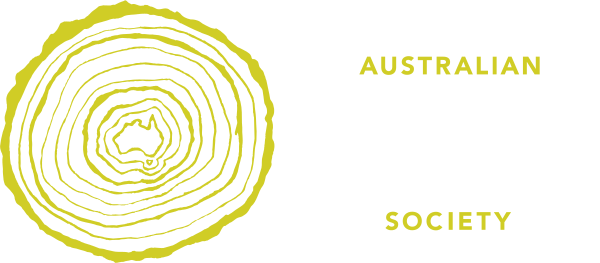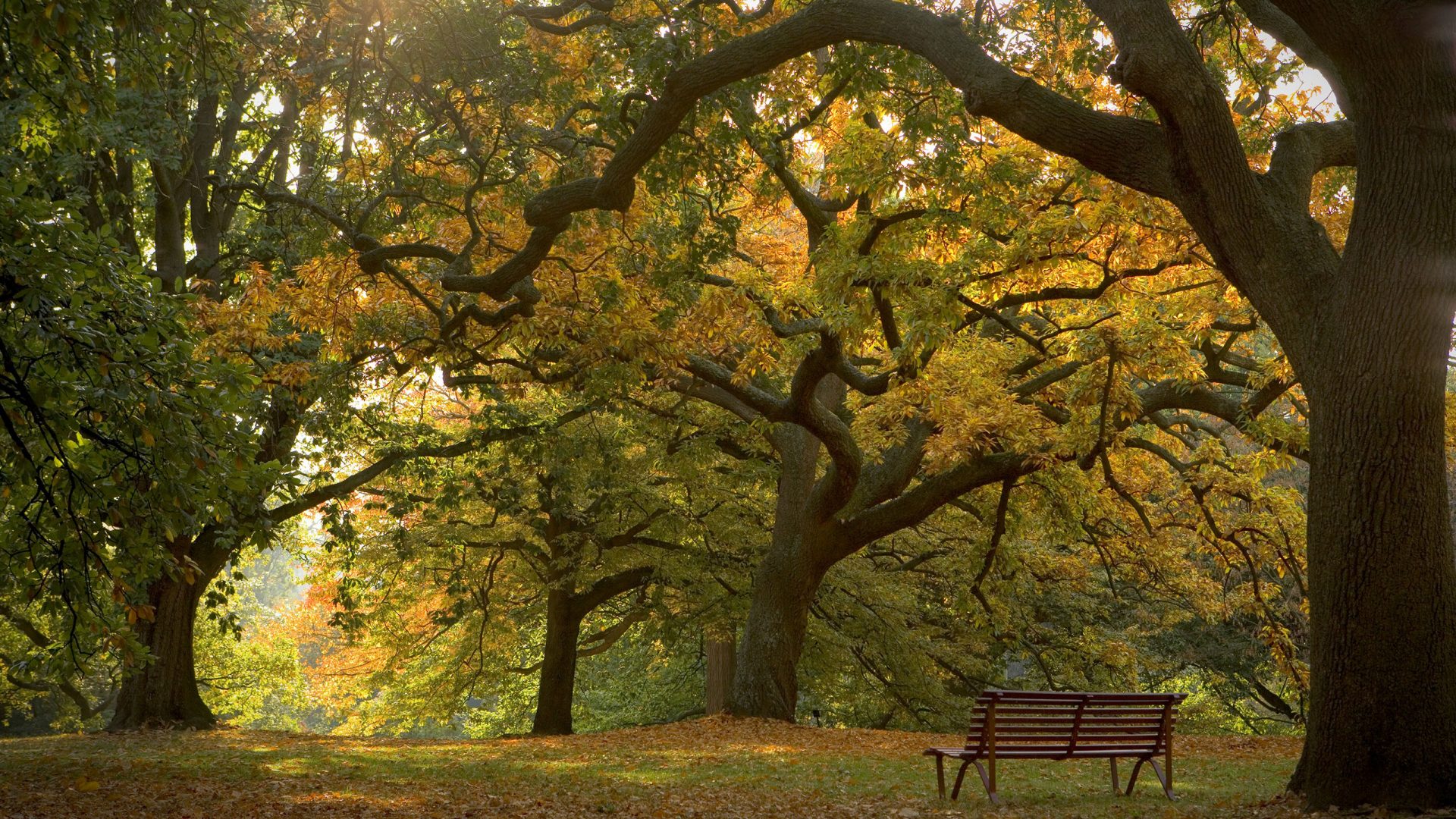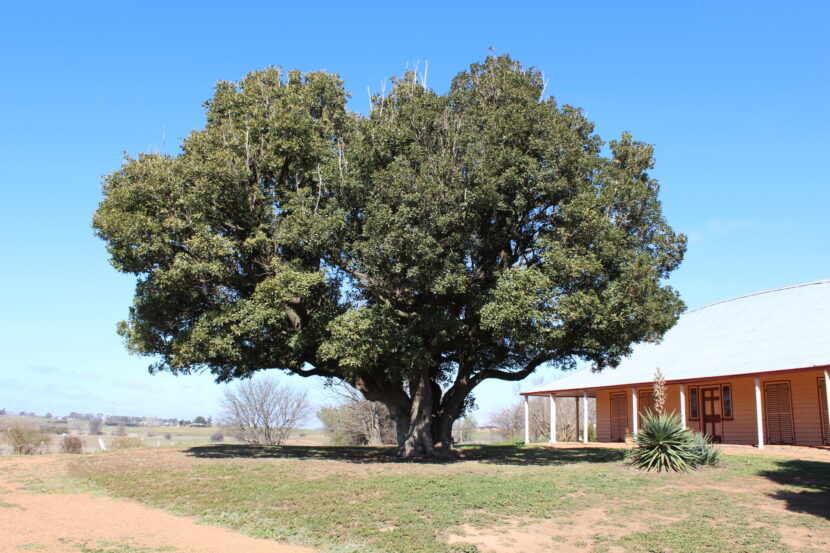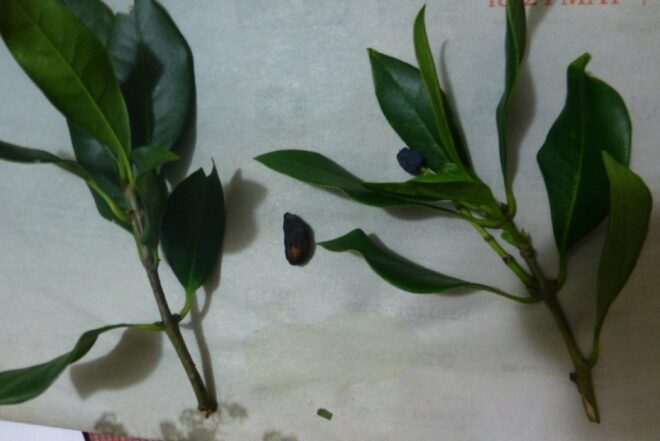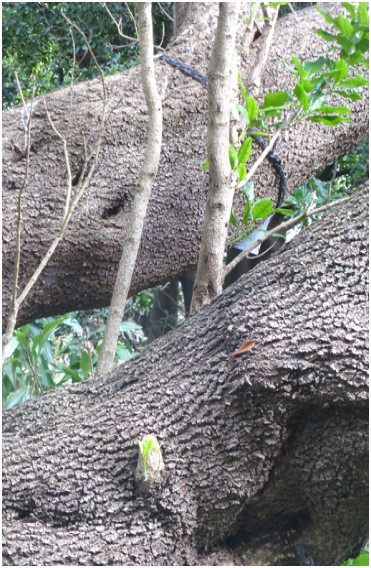Palo blanco or Canary Island olive trees (Picconia excelsa) in Australia and New Zealand: to date 38 in Australia (13 of these in NSW) and 25 in New Zealand
Stuart Read, International Dendrology Society
Last updated: 16/04/2021
This rainforest (‘cloud or laurel forest’) tree is in the olive family (Oleaceae). It is endemic to the Canary Islands (recorded on five of the islands) and endangered in the wild due to timber clearance of that vegetation type and on the islands’ northern cliffs. It is at best extremely rare in Australia.
Its relative, pau branco, P. azorica, is even rarer in Australia, to my knowledge. Geoff Bogle at Hoddles Creek arboretum has one, c5 x 5m, some 20 years old (Don Teese, pers. comm., 4/10/2020). This came from Bill Funk at Mereweather Arboretum, near Dunkeld. His is some 2 to 3m tall and he has a spare one in the nursery! (Bill Funk, pers. comm., 6/10/2020).
Picconia excelsa is a large shrub or small tree to 8 (-12, in Australia) meters, endemic to the Azores, scattered in coastal forest to 750m above sea level. Even in England, there is only one record of specimens of this, near Jermyn’s House at Sir Harold Hillier Gardens (1994 collection by E. Sjoren) (Grimshaw & Bayton, 2009, 561).
The tree has fragrant white flowers in spring, olive like fruits and heavy, white timber. This timber is valuable for tools and other uses, leading to culling. It is so heavy it does not float. The tree has simple, entire leaves, arrayed oppositely on the branch, dark green, glossy and leathery, with acute (pointed) tips. Bark is whitish/fawn and slightly warty/pimply on close inspection. With age it gets increasingly ‘shingly’ (see photos below).
Picconia twigs showing ripe and ripening ‘olive’ like fruit. Note the glossy, leathery, glabrous leaf surfaces, parallel veining, pointed tips to the leaves and their opposite arrangement on the stems (pic: ex-RBG Melbourne tree, Stuart Read)
Picconia is not listed in any of the Camden Park Nursery or any other NSW (early to mid-nineteenth century) or Victorian (1855-89) nursery catalogues (perhaps reflecting difficulty in propagation rather than non-existence?). It is not listed in Hortus Camdenensis (www.hortuscamden.com c.1820-60s) nor Sydney Living Museums’ Colonial Plants Database www.sydneylivingmuseums.com.au/research) both of which focus on the nursery trade pre-1860 in NSW, based on records.
What are listed are multiple species/varieties of Olea spp./O. europaea subspecies. One of these is O. capensis – from South Africa – which is not Picconia excelsa but a relative, the black ironwood. It has larger leaves (though leathery, shiny and pointed-tipped, and olive-like fruits). A specimen was presented to Camden Park’s William Macarthur in 1822/3 and perhaps is even rarer in Australia. A specimen of black ironwood survives today at Camden Park, north-east of the east service wing.
Scottish/English polymath author/publisher/designer J.C. Loudon records Picconia excelsa (Flora Britannicus, 1830) as introduced into the United Kingdom in 1784. His Arboretum (1838) discusses specimens growing outside in shelter, one in Ireland. Perhaps this ‘tenderness’ worked against it?
While the timespan of both Hortus Camdenensis and the Colonial Plants Database stops at 1860, it can be supposed that Picconia excelsa came to Camden Park after that date. Either direct or indirectly. Camden Park Nursery and Garden volunteers (the late) Colin and his son, Euan, Mills propagated Picconia cuttings, resulting in one new plant in Camden Park’s Bidwill Garden, now some 4m tall.
Old palo blanco (with drastically leaning trunk) with vertical young shoots off the old trunk – Royal Botanic Garden, Sydney’s inner garden. Note the bark, which is very like that of Quercus ilex, holm/holly/evergreen oak (pic: Stuart Read).
Hilliers Trees and Shrubs (UK) omitted it in its 1977 edition, but the 1991 edition lists it, with synonyms Notolaea speciosa and Olea speciosa, as introduced into the United Kingdom in 1784. It notes a splendid specimen in the Abbotsbury Subtropical Gardens near Weymouth and, that at Romsey, Hampshire it is slow growing and survives uninjured in all but the coldest winters.
It is not listed in the English Heritage Handbook – the Management and Maintenance of Historic Parks, Gardens & Landscapes (2007) with long lists of trees, shrubs, dates of introduction to the UK).
New Trees – Recent Introductions to Cultivation (Grimshaw & Baynton, 2009, Royal Botanic Gardens, Kew in association with the International Dendrology Society, charts 1970+ introductions of species into northern hemisphere (UK, USA, European) gardens. Its entry on Picconia excelsa (p.561), notes it grows well in coastal southern England and Ireland and can form large trees in mild conditions. It also notes the publication of this species ‘in W.J. Bean’s (1914, revisions and supplements published up until 1988)’s Trees and Shrubs hardy in the British Isles, as Notolaea excelsa (Aiton) Webb & Bert.).
Cedric Bryant (2017) notes that the United Kingdom has some 16 Picconia excelsa trees, dating from c.1914-1994.
Examples in Australia and New Zealand
ACT
1-100 (young, yet to be planted out) Canberra, Yarramundi, National Arboretum of Australia, to represent Spain (N.B.: plants propagated by Euan Mills of the Australian Botanic Garden at Mt. Annan from Camden Park’s four trees).
NSW
- Royal Botanic Gardens, Sydney – middle garden, near Cactus garden / Wollemi pine (c.1890s-1920s – Maiden era) (Entwisle);
- “ “ – near the Morshead Gate (Shakespeare Place / State Library / Bent Street), c1950s (Entwisle);
- Camden Park, South Camden (c1820/30) back (garden front) lawn on east of the house;
- Camden Park, South Camden (c.1820/30?) shrubbery north-east of the house;
- Camden Park, South Camden (c.1820/30?) shrubbery north-east of house (collapsed, alive);
- Camden Park, South Camden (c2000) in driveway ‘triangle’ north-west of house, planted by Colin Mills (c.3 x 1.5m, 10/2016);
- Camden Park, South Camden (c.2010?) in ‘Bidwill Garden’, towards Stables, c.3 x 1.5m
- Denham Court, Ingleburn (c1850s) – north west of house near the swimming pool;
- Yasmar, Parramatta Road, Haberfield (c1850s) eastern & western shrubberies on main drive (2 specimens) one SE of house’s S. Eastern corner;
- Yasmar, Haberfield (c1850s) – other nearer to Parramatta Road gate, Eastern side;
- OCTEC P/L, fmr. Croagh Patrick Orphanage, 10 Park Street, Orange (c1880s) north side of the drive;
- Cooma Cottage, Yass Junction (c1840 house – tree could be 1840s/1850s) – east side (front door) of oldest wing of house, 9m x 12m x 4.25m circumference (2010). Former CC volunteer Marion McCarthy suggests Alexander Berry could have been a source for the tree as he was a friend of Hamilton Hume’s father. As Hume’s father died in 1849, this suggests that if Berry supplied the Picconia to Hume, via his father, it would need to have been planted at Cooma Cottage prior to 1849, when his father died (Baddeley/McCarthy; National Register of Big Trees);
- Swifts, Darling Point Road, Darling Point, Sydney (c.1870s mansion) shrubbery east of house
- Alnebank, Gerringong, large tree (Mills, Colin, pers. comm.).
NB: removed: Waverley, bet. McPherson, Albion Streets and Bronte Road, St. Catherine’s School – tree (11 x 4m, 300mm trunk) removed 2014 as part of additions. Cuttings being taken and ‘two to be replanted’ (?) (Claire Baddeley, pers. comm., 15/10/2020)
VIC
- Royal Botanic Gardens Melbourne, northern border near Tan Track (3 specimens; one circumference 3.85m, height 10.5m, width 15.7m (in 1989);
- “ “
- “ “
- Alexandra Gardens, rockery south of the boat sheds, one (likely Guilfoyle era – i.e. pre-1910. ID courtesy of John Hawker, 10/2019);
- Geelong Botanic Gardens, (c1857-58 – two specimens of that age) – one huge one inside northern boundary, NT(VIC) listed tree near Curator’s cottage (in Eastern Park, just outside garden’s eastern boundary); both could have been planted by Curator, Daniel Bunce (appointed 1857), though no proof;
- “ “ – NT(VIC) listed tree near Curator’s cottage just outside garden boundary (east)
- “ “ – Young tree in the ‘21st century’ garden addition at the front (north) and
- “ “ – another specimen nearby
- Eastern Park, 1-45 Garden Street, Geelong, 15-18m x 3.9m girth, 2004 (VHD71106)
- Kamesburgh, North Road, Brighton, single tree (John Hawker, Janet O’ Hehir, pers.comm.s);
- Melbourne University, near Nelson Hall / the Law School, Parkville (‘near 100 years old’) perhaps via von Mueller? (Hawker, pers. comm., Nat. Trust of Australia (Vic). significant tree, 17x13m)
- Grimwade House, cnr. Balaclava and Orrong Roads, Caulfield, c1875 house, now part of Melbourne Grammar School. 14-15m wide x 2.27m girth, 2003, est’d. 1892 (VHD 70979)
- Wirigil, 590 Wiridgil Road, Weerite, Camperdown, 1885 house for Manifold family on an outstation of Purrumbete, 1907 addition, tree c1885 (NTA (Vic) say c.1904), largest specimen in Victoria (15 x 15.8m x 4.14m girth in 1994)(NTV listed)(O’ Hehir, Hawker, VHD 70954);
- Kynaston, 70 Bambra Road, Caulfield North, ‘late Victorian’ (VHD 35575);
- Mereweather Arboretum, near Dunkeld, W. Victoria, one in the arboretum in an exposed site is 2-3m tall (Bill Funk, pers. comm., 6/10/2020);
- Mereweather Arboretum, near Dunkeld, W. Victoria, a second is in a more sheltered spot and doing much better (Bill Funk, pers. comm., 6/10/2020).
- Hoddles Creek arboretum, Geoff Bogle, c.20 years (i.e. 2000+), 6 x 3m (Don Teese, pers. comm., 10/2020)
- Warrnambool Botanic Garden, Warrnambool, 2.8m tall (2020) planted in 2009, purchased from Bill Funk (John Sheely, instagram post/pers. comm., 22/12/2020);
- Dalvui, Camperdown, young – 2m tall, behind (W of) house near stables.
SA
- Adelaide Botanic Gardens, one tree (western side of plane tree avenue);
- Marybank, (c1842) off Montecute Road, Adelaide Hills, grove of four trees west of house;
- “
- “
- “ .
New Zealand
- Auckland, Devonport, Vauxhall Reserve, a young tree (Wilcox, 2012);
- Auckland, Remuera, St. Kentigern School (ACC proposed district scheme) (Gardner): likely from the same source as the Wilson Home, Takapuna one. The Wilsons owned both. They, with the Horton family, were publishers of the NZ Herald newspaper (Webb, pers. comm., 29/8/2020)
- Auckland, Remuera, 115 Victoria Avenue (ACC proposed district scheme) (Gardner). c.12 m tall. Evergreen, multi-trunked (Cameron, at http://www.aucklandmuseum.com/collection/object/am_naturalsciences-object-274483;
- Auckland, Mt. Eden, 2 Woodside Avenue (Gardner) (Auckland Signif. Tree Rgr. Item 318)
- Auckland, Mt. Eden, 277 Mt. Eden Road (Gardner) near Epsom Avenue (AVH)
- Auckland, Mt. Albert, 2 Wesley Street, National Forestry Herbarium (Bill Sykes) (AVH)
- Auckland, Freemans Bay, Western Park (AVH);
- Auckland, Takapuna, Wilson Home (now an aged care facility) (Gardner), likely from the same source as the St. Kentigern School, Remuera one (Webb, pers. comm., 29/8/2020)
- Auckland, North Titirangi, Titirangi Road (near cnr. Rua Road) (AVH);
- Auckland, Ihumatao Road, farmhouse driveway (Gardner);
NB: Gardner notes that all are less than 100 years old, he adds they rarely form fruit.
- Auckland, St. John’s, 78 Merton Road (AVH);
- Auckland, Manurewa, Auckland Botanic Garden has ‘several’ (Webb, pers. comm., 29/8/2020; RNZIH Register of Significant Trees)
- Auckland, as for (10) (Webb, pers. comm., 29/8/2020; RNZIH Register of Significant Trees)
- Auckland, as for (10) (Webb, pers. comm., 29/8/2020; RNZIH Register of Significant Trees) (Webb, pers. comm., 29/8/2020; RNZIH Register of Significant Trees);
- Auckland, Freemans Bay, Western Park Reserve, c20 year old tree (Chris Webb, pers. Comm., 1/12/2020;
- Paeroa, Domain, behind the main street, c15m tall (Chris Webb, pers. comm., 28/10/2020) (https://inaturalist.nz/observations/37445147 c/o Ian Cadwallader, pers. comm., 17/10/2020;
- Gisborne, Tiniroto, Eastwoodhill Arboretum (1950s+), young palo blanco, trunk c.20cm diam., 8 x 6m;
- 18. Gisborne, Abbotsford Station arboretum, (is that now Hackfalls?) planted by Bob Berry, from seed, in 1963 (Brad Cadwallader, pers. comm., 15/4/2021);
- Hawkes Bay, Lindisfarne College, near the assembly hall (Williams, 1988, 17)
20-40. Hawkes Bay, Hastings, Frimley Road, Frimley Park. Twenty trees, a large group near the reserves depot and others scattered around the park. Planted c1880 (Brad Cadwallader, pers. comm., 15/4/2021).
- Wairarapa Plains, location only as GPS position (AVH);
- Golden Bay, Clifton, Boyle Street, Clifton Cemetery (mis-identified as coastal (NZ) maire (Nestigis apetala) on Tasman District Council protected tree schedule), 15 x 13 x 18m, multi-trunked (NCC, Brad Cadwallader, pers. comm., 12/10/2020);
- Nelson, Bridge Street, Queens Gardens (1887+, formally opened 1892). Tree was likely planted in 1892, 24m tall, 13-21m wide, 468cm girth – misidentified as Phillyrea latifolia angustifolia on the City’s Protected Tree Schedule for decades and in a 1974 NZFRI survey (Burstall) (Brad Cadwallader, pers. comm., 18/10/2020 (AVH), at Historic and notable trees of New Zealand : Marlborough, Nelson, Westland – Forest Mensuration Reports – Manaaki Whenua Landcare Research Digital Library). Image of tree is at imageViewer (800×1067) (mydoforms.appspot.com);
- Christchurch, Tai Tapu, Otahuna, single tree (c15 x 6 x 0.4m) (IDS 2013) this property was Cecil Heaton-Rhodes’s showpiece rural estate. His wife was a Clark from Glenara, Bulla, Victoria. The property is now an upmarket hotel.
Lost NZ palo blanco trees:
Wellington, Wellington Botanic Garden, near Tinakori Road entry – removed 3/2012 due to storm damage from an adjacent oak’s falling branches. Was over 10m tall, trunk c.30cm diam. Tree propagated for planting elsewhere (Sole).
Nelson, SH6, at the former Ruffell Estate (Brad Cadwallader, pers. comm., 12/10/2020) GPS position only (AVH; Brad Cadwallader, ibid; Brad Cadwallader, 15/4/2021)
Nelson, 180 Kawai Street, Seven Oaks, behind the (Victorian) mansion. It was larger than the Queens Gardens tree (42, above) is now (Brad Cadwallader, pers. comm., 12/10/2020). Removed in the mid-1990s (Brad Cadwallader, pers. comm., 15/4/2021)
Sources:
AVH = Australasian Virtual Herbarium, search (of New Zealand) at https://avh.ala.org.au/occurrences/search?taxa=Picconia+excelsa#tab_mapView
Baddeley, Claire & Chalmers, Corrine, ‘Hamilton Hume’s Garden: living history at Cooma Cottage’, in Australian Garden History Society, Australian Garden History, v.32(2), October 2020, 24-27;
Baddeley, Claire, pers. comm., 15/10/2020;
Bramwell, D. & Z., 2001, Wild Flowers of the Canary Islands, Edicion Rueda SL, pp. 28, 253;
Bryant, Cedric, ‘Focus on trees – The rarest of trees’, in Heritage in Trust, 7/2017, (first published in the May-July 2017 Bulletin of the Horticultural Society of Canberra);
Burstall, S.W., 1974, Historic and Notable Trees of New Zealand: Marlborough, Nelson, Westland, 2/1974, Forest Mensuration Report No. 21, Production Forestry Division, NZ Forest Research Institute, http://digitallibrary.landcareresearch.co.nz/digital/collection/p20022coll11/id/29,
Entwisle, Tim, ‘Ordinary Plant growing in Yass Garden’, Talking Plants blog, 1/10/2010 online at http://talkingplants.blogspot.com.au/2010_06_01_archive.html;
Entwisle, Tim, ‘White wood and white windmills from Macaronesia’, Talking Plants blog, 15/10/2019 online at http://talkingplants.blogspot.com/2019_10_15_archive.html;
Forbes, Stephen, (fmr. Director, Adelaide Botanic Garden & IDS member) pers. comm. 14/1/13 (re introduction / records of this species in that garden, 1977-1993);
Gardner, R.O., 1989, ‘Picconia excelsa (Oleaceae), in Auckland Botanical Society journal, 44(2): 41-42. Online at http://bts.nzpcn.org.nz/bts_pdf/Auck_1989_44_2_41-42.pdf;
Grimshaw, Ross and Bayton, Ross, 20009, New Trees – Recent Introductions to Cultivation, Royal Botanic Gardens Kew in assn. with the International Dendrology Society;
Hawker, John, (Heritage Victoria, IDS member) pers. comm’s, 6/2/2013; 7/2015;
IDS 2013 = International Dendrology Society, New Zealand members’ tour, 12-14/4/2013, Christchurch and environs (visit);
Jellyman, A.D. (Allan), ‘1988 I.D.S. Tour to Hawkes Bay’, in International Dendrology Society, Yearbook – 1988, IDS, UK;
Jones, George, “Hard to Believe/Of Interest” in Australian Garden History 16(5), 5-6/2005, 21;
McCarthy, Marion, pers. comm., 2010 (Yass Historical Society, Museum and Cooma Cottage, Yass Junction National Trust of Australia (NSW) volunteer);
Mills, Colin, personal communication, 9/12/2011;
NCC = Nelson City Council, ‘Queens Gardens’, online at http://www.nelson.govt.nz/recreation/recreation/parks-and-reserves/queens-garden/
New South Wales Heritage Inventory, www.heritage.nsw.gov.au/search
O’Hehir, Janet, (Friends of Camperdown Botanic Garden, Vic., IDS member) pers. comm., 7/2015
Pascoe, Gwen, 2012, ‘Long Views and Short Vistas’, Victoria’s 19th century Public Botanic Gardens, Australian Scholarly Publishing
Read, Stuart, Morris, Colleen & Hawker, John, “Correspondence on Colonial Plants” in Australian Garden History 16(4), 2-4/2005, 18-20;
Rogers, Ian, 2018, Kangaroo Grassland to Geelong Botanic Gardens and Eastern Park – a chronological pictorial history, Ian Rogers, xxi, 52, 234, 257, 396, 437;
Salmon, Jayne, letter to the editor, Australian Garden History 16(5), 5-6/2005, 22;
Sole, David, ‘Botanic Bulletin’ (Picconia excelsa – a landmark falls: Cover title & image), in Friends of the Wellington Botanic Garden Newsletter, March 2012, 2-3;
Victorian Heritage Database, https://vhd.heritagecouncil.vic.gov.au/
Webb, Chris, personal communications (RNZIH Councillor)
Wilcox, Mike, Auckland’s Remarkable Urban Forest, Auckland Botanical Society, 2012, 114 (and pers. comm., 12/4/2013). Mike is also an IDS member.
